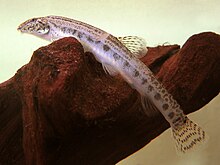Spined loach
| Spined loach | |
|---|---|

| |
| Scientific classification | |
| Domain: | Eukaryota |
| Kingdom: | Animalia |
| Phylum: | Chordata |
| Class: | Actinopterygii |
| Order: | Cypriniformes |
| Family: | Cobitidae |
| Genus: | Cobitis |
| Species: | C. taenia
|
| Binomial name | |
| Cobitis taenia | |
| Synonyms | |
The spined loach (Cobitis taenia) is a common freshwater fish in Europe. It is sometimes known as spotted weather loach, not to be confused with the "typical" weather loaches of the genus Misgurnus. This is the type species of the spiny loach genus (Cobitis) and the true loach family (Cobitidae).
Description
The spined loach typically reaches an adult length of 8–10 cm (3.1–3.9 in), although females may grow up to 12 cm (4.7 in). Adults weigh between 20–60 g (0.7–2.1 oz). Their backs feature a yellow-brown colouring interspersed with many small grey or brown

Distribution and relationships
It is found from the
Populations of southwestern Europe were formerly included in this species, but actually represent distinct branches of Cobitis. A member of
Ecology and behaviour
Clear oxygen-rich water is preferred by the spined loach, be it slowly flowing brooks, rivers or still water. They are found near flat and sandy or stony areas, frequently in large numbers. The spined loach is often kept as an ornamental fish in aquaria.
During the day, they bury themselves in the bed of the body of water, leaving only the head and tail exposed. At night, when the loach is most active, sand on the riverbed is consumed, and with it small animals and other organic material. Sand, stripped of nutrients, is ejected through the
Spined loaches possess the ability of intestinal breathing. This stop-gap measure sustains the spined loach when the water around it is
The spawning season is from April to June. The females produce between 300 and 1,500
The spined loach's lifespan is between 3 and 5 years, with the maximum reached in captivity being 10 years.
See also
- Loach
Footnotes
- . Retrieved 12 November 2021.
- ^ "Spined loach (Cobitis taenia) - Special Areas of Conservation".
- ^ Perdices et al. (2008)
References
- Froese, Rainer; Pauly, Daniel (eds.) (2005). "Cobitis taenia" in FishBase. November 2005 version.
- "Cobitis taenia". Integrated Taxonomic Information System. Retrieved 19 March 2006.
- Freyhof, J. (2011). "Cobitis taenia". . Retrieved 12 November 2021.
- Perdices, Anabel; Bohlen, Jörg & Doadrio, Ignacio (2008): The molecular diversity of adriatic spined loaches (Teleostei, Cobitidae). (HTML abstract)

